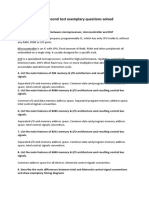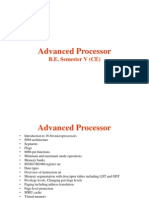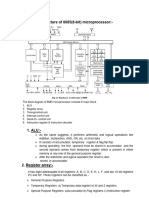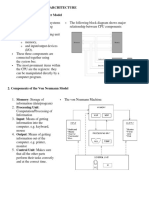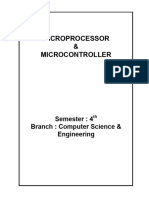0 ratings0% found this document useful (0 votes)
35 viewsTutorial6 CHAPTER 4 (Part 2)
This document provides details on the data path of a computer system including:
1. A diagram of the data path showing memory control registers, ALU, shifter, registers and buses.
2. Definitions for common data path terms like CPP, TOS, OPC, and H.
3. A description of the four main durations that drive the data path signals.
4. Two ways for a data path to communicate with memory - a 32-bit word-addressable port and 8-bit byte-addressable port.
Uploaded by
sajan gcCopyright
© © All Rights Reserved
Available Formats
Download as PDF, TXT or read online on Scribd
0 ratings0% found this document useful (0 votes)
35 viewsTutorial6 CHAPTER 4 (Part 2)
This document provides details on the data path of a computer system including:
1. A diagram of the data path showing memory control registers, ALU, shifter, registers and buses.
2. Definitions for common data path terms like CPP, TOS, OPC, and H.
3. A description of the four main durations that drive the data path signals.
4. Two ways for a data path to communicate with memory - a 32-bit word-addressable port and 8-bit byte-addressable port.
Uploaded by
sajan gcCopyright
© © All Rights Reserved
Available Formats
Download as PDF, TXT or read online on Scribd
You are on page 1/ 3
TUTORIAL6
CHAPTER 4(Part 2)
1. Draw a data path diagram which consists of memory control registers, ALU, shifter,
additional registers, buses, etc and add data path timing to the diagram in order to
show details of the diagram.
- A data path diagram which consists of memory control registers, ALU, shifter,
additional registers, buses:
2. Define the following terms:
a. CPP
CPP is known as Constant Pool Pointer. It is pointer to the bottom of the
constant pool.
b. TOS
TOS is known as Top of Stack. It is a data value at the top of the stack.
c. OPC
OPC is known as Old PC. It is a scratch or temporary register typically used
for branching and the temporary storage of old PC values in computations.
d. H
H is known as Holding. It is a temporary register for holding one of the two
ALU operands.
3. There are four main durations which drive data path to activate the signals. Name
and describe them.
- Most registers can drive their contents onto the B bus. The output of the ALU drives
the shifter and then the C bus, whose value can be written into one or more registers at
the same time.
The short diagonal line labeled ‘‘6’’ in Fig indicates that there are six ALU control
lines.
4. Briefly describe two different ways to communicate with memory.
- The two different ways to communicate with memory is 32-bit, word-addressable
memory port and an 8-bit, byte-addressable memory port.
5. Describe five functional groups of control signal in data path diagram.
- To control the data path, we need 29 signals. These can be divided into five functional
groups they are:
a. 9 Signals to control writing data from the C bus into registers.
b. 9 Signals to control enabling registers onto the B bus for ALU input.
c. 8 Signals to control the ALU and shifter functions.
d. 2 Signals (not shown) to indicate memory read/write via MAR/MDR.
e. 1 Signal (not shown) to indicate memory fetch via PC/MBR.
6. Briefly discuss what sequencer is.
- Sequencer is responsible for controlling how the data path is decided which of the
control signals should be enabled on each cycle. It is responsible for stepping through
the sequence of operations necessary for the execution of a single ISA instruction.
7. Describe two kinds of information that sequencer produces.
- The sequencer must produce two kinds of information each cycle:
a. The address of the microinstruction that is to be executed next.
b. The state of every control signal in the system.
8. Describe the concept of stacks and provide illustration if necessary.
- A stack is an applied structure comprising of a lot of homogeneous components and
depends on the guideline of toward the end in first out (LIFO). It is a generally
utilized dynamic information type with two significant tasks, specifically push and
pop. Push and pop are completed on the highest component, which is the thing most
as of late added to the stack. The push activity adds a component to the stack while
the pop activity expels a component from the top position. The stack idea is utilized in
programming and memory association in PCs.
You might also like
- Implementation of A 16-Bit RISC Processor Using FPGA Programming100% (4)Implementation of A 16-Bit RISC Processor Using FPGA Programming25 pages
- The Central Processing Unit (CPU) : NextNo ratings yetThe Central Processing Unit (CPU) : Next26 pages
- Svcet: 1. What Is MIPS, MIPS Instruction, MIPS ImplementationNo ratings yetSvcet: 1. What Is MIPS, MIPS Instruction, MIPS Implementation24 pages
- Cs2253 - Computer Architecture 16 Marks Question Bank With Hints Unit - I 1. Explain Basic Functional Units of Computer. Input UnitNo ratings yetCs2253 - Computer Architecture 16 Marks Question Bank With Hints Unit - I 1. Explain Basic Functional Units of Computer. Input Unit18 pages
- Internal Architecture of 8085 Microprocessor: A. Control UnitNo ratings yetInternal Architecture of 8085 Microprocessor: A. Control Unit17 pages
- EMISY Second Test Exemplary Questions Solved-3No ratings yetEMISY Second Test Exemplary Questions Solved-315 pages
- ELEC 2441 - Computer Organization and MicroprocessorsNo ratings yetELEC 2441 - Computer Organization and Microprocessors18 pages
- Computer Architecture Lesson 4 (Data Paths in The CPU)No ratings yetComputer Architecture Lesson 4 (Data Paths in The CPU)10 pages
- 1.Introduction to Microprocessor and Organisation of 8085_47c83415-2851-4f59-8893-2ab228eb0a33No ratings yet1.Introduction to Microprocessor and Organisation of 8085_47c83415-2851-4f59-8893-2ab228eb0a3385 pages
- Advanced Processor: B.E. Semester V (CE)No ratings yetAdvanced Processor: B.E. Semester V (CE)130 pages
- Design and Characterization of A CMOS 8-Bit Microprocessor Data PathNo ratings yetDesign and Characterization of A CMOS 8-Bit Microprocessor Data Path6 pages
- 1.introduction To Microprocessor of 8085 - 2024No ratings yet1.introduction To Microprocessor of 8085 - 202477 pages
- IIMS College: Putalisadak, Kathmandu, NepalNo ratings yetIIMS College: Putalisadak, Kathmandu, Nepal8 pages
- Guidelines To Complete The Sales Management System: P3Ilgr8Nj8Iwkxh6T8Iim94Nvzhm03F2IzstamauoNo ratings yetGuidelines To Complete The Sales Management System: P3Ilgr8Nj8Iwkxh6T8Iim94Nvzhm03F2Izstamauo1 page
- CC118 Computer Organization and ArchitectureNo ratings yetCC118 Computer Organization and Architecture4 pages
- Tutorial 2: CC118 Computer Organisation and ArchitectureNo ratings yetTutorial 2: CC118 Computer Organisation and Architecture3 pages
- Tutorial 1: Computer Organization and ArchitectureNo ratings yetTutorial 1: Computer Organization and Architecture4 pages
- CC118 Computer Organization and ArchitectureNo ratings yetCC118 Computer Organization and Architecture4 pages
- IIMS College: Putalisadak, Kathmandu, NepalNo ratings yetIIMS College: Putalisadak, Kathmandu, Nepal4 pages
- IIMS College Putalisadak, Kathmandu, NepalNo ratings yetIIMS College Putalisadak, Kathmandu, Nepal11 pages
- An Exploratory Study On Critical Success Factors in Cloud Computing Adoption in Banking Sector of NepalNo ratings yetAn Exploratory Study On Critical Success Factors in Cloud Computing Adoption in Banking Sector of Nepal19 pages
- Model 2700 Multimeter/ Data Acquisition System: Integra SeriesNo ratings yetModel 2700 Multimeter/ Data Acquisition System: Integra Series8 pages
- WiNet-S Auto-Upgrade Via Local Access and WiNet-S Plant CreationNo ratings yetWiNet-S Auto-Upgrade Via Local Access and WiNet-S Plant Creation22 pages
- Manoj Regmi Intern Report For Mid DefenceNo ratings yetManoj Regmi Intern Report For Mid Defence27 pages
- File - Byzantine Trebuchet Skylintzes - JPG - WikipediaNo ratings yetFile - Byzantine Trebuchet Skylintzes - JPG - Wikipedia4 pages
- Python Environment Setup and EssentialsNo ratings yetPython Environment Setup and Essentials54 pages
- Crack SSH Private Key With John The Ripper - CodelivlyNo ratings yetCrack SSH Private Key With John The Ripper - Codelivly8 pages
- Simatic Hmi HMI Devices Migration Guide Comfort PanelsNo ratings yetSimatic Hmi HMI Devices Migration Guide Comfort Panels52 pages
- WIT-Color Ultra 9600 High Definition Printer User ManualNo ratings yetWIT-Color Ultra 9600 High Definition Printer User Manual62 pages
- Micronics PF330 PF220 Brochure English v9No ratings yetMicronics PF330 PF220 Brochure English v94 pages
- ISTQB CTFL v4.0 Sample-Exam-D-Questions v1.0 OrganizedNo ratings yetISTQB CTFL v4.0 Sample-Exam-D-Questions v1.0 Organized15 pages




















